Change Agent
There are lots of Lafayette memories for Alison Byerly. The now iconic win against Lehigh at Yankee Stadium, on the occasion of the 150th meeting of the two football teams. The opening of Rockwell Integrated Sciences Center—“a signature building that conveys a sense of energy and innovation,” as she describes it. The five- minute walks across the Quad that, given all the conversation activity she finds along the way, turn into half-hour walks.
If this is an academic year sure to provide different memories—it is, after all, the year of a pandemic—Byerly is finishing a presidency that, by any measure, has been transformative. There are the new buildings, the new programs, the new models for growth, and, of course, the astoundingly successful fundraising campaign: $425 million is quite a number to reckon with. But above all else, Byerly will be remembered as a leader who at once embodied the values of the College and placed it on a trajectory to get ever stronger.
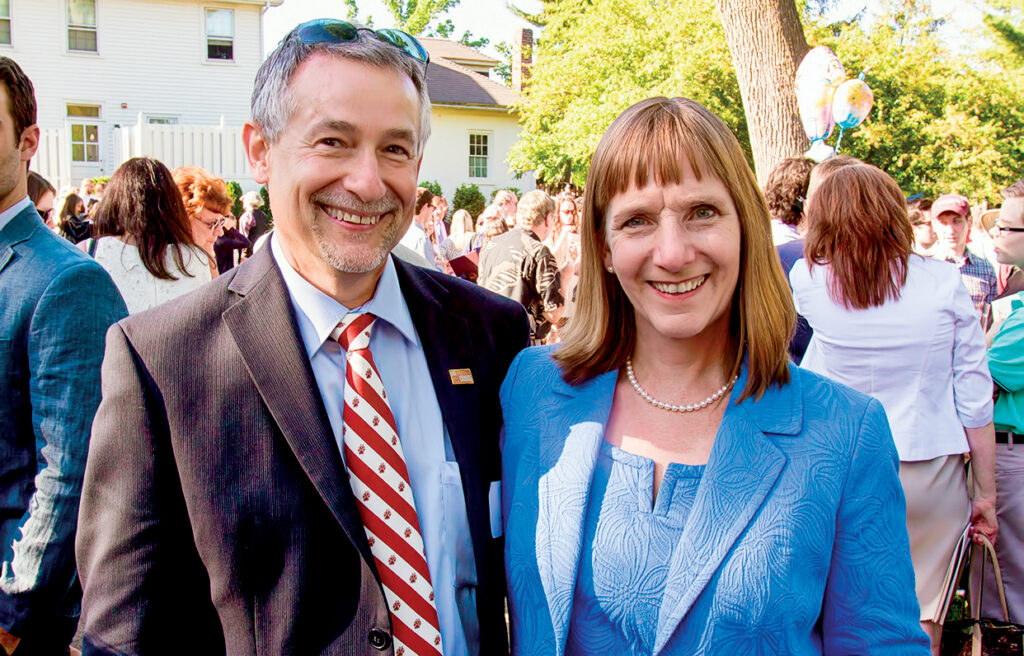
Byerly and her husband, Steve Jensen, host a post-Commencement celebration for students and families at their house.
“This is a job that has called on every resource I have,” Byerly says. “There’s a lot of intellectual effort in thinking through knotty issues. There’s also a lot of emotional investment that, at times, is all-consuming. One thing I learned about myself is that I like the complete investment in the community. Meeting with alumni, chatting with students, taking in campus performances, attending brilliant lectures by faculty members—these get to the cheerleading aspects, the symbolic aspects, of the president’s role.” The pandemic has supplanted much of that, of course. All of which has made the old normal even more of a touchstone for Byerly. “I think one thing the pandemic has highlighted,” she says, “is the strength and the power of the community that a residential liberal arts college defines.”
There may be no better example of Byerly’s brand of enthusiasm than her role in fundraising, particularly the cleverly conceived piece of the campaign called the President’s Challenge, with a financial aid focus. “Her passion for what the campaign meant for the future of Lafayette was evidenced not just in what one would think a typical college president would do. It was evidenced in what they might not do,” says Kim Spang, vice president for development and college relations. “How many college presidents would jump in a pool, lip-sync a Hamilton rap, or flip pancakes, all in the name of raising funds for financial aid? Her strong commitment helped communicate to alumni, parents, and friends a compelling case for a stronger Lafayette.”
The case for a stronger Lafayette seems all the more compelling at a time of crisis in higher education.
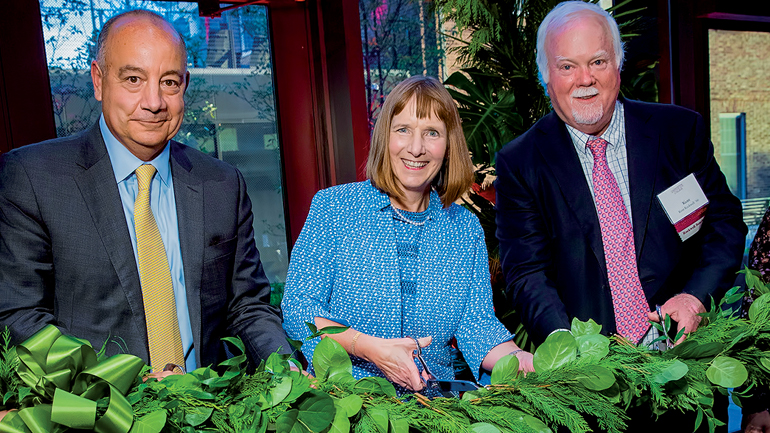
Byerly celebrated the dedication of Rockwell Integrated Sciences Center with Robert Sell ’84 and S. Kent Rockwell ’66.
“Alison has led us through an unprecedented time, a year of interruption,” says Robert Sell ’84, chair of the Board of Trustees. “In a broader sense, she has been an exceptional steward, in that she is leaving the place better than she found it. She has been dedicated to figuring out how we can evolve the Lafayette experience so that the College occupies a place of uniqueness. She doesn’t want Lafayette to try to become someplace else. She doesn’t want Lafayette to look just like another institution. Rather, she has this keen sense of what Lafayette could be, of how it could carve out its own identity.”
Alison doesn’t want Lafayette to look just like another institution.
Rather, she has this keen sense of what Lafayette could be, of how it could carve out its own identity.
chair of the Board of Trustees
Around that identity, Sell finds it significant that, under Byerly, the College has conspicuously and deliberately embraced its namesake. “Alison has employed the image, the language, the values of the Marquis de Lafayette.” Over the years of her presidency, fundraising efforts featured Byerly dressing in the garb of the Marquis; background about the Marquis has been highlighted in admissions brochures; and the sword of the Marquis, once relegated to the archives, is brought out annually to play a major role at Commencement. “It really matters that we know and honor the person from whom the College derives its name,” Sell says. “For Alison, understanding Lafayette the individual is an avenue to understanding the institution—and then to positioning it in a way that is visible and authentic.”
It doesn’t take long in conversation for another well-positioned observer of the Byerly presidency, Eric Ziolkowski, Helen H.P. Manson Professor of Bible, to reach for that revealing word: unprecedented. This pandemic year, he says, “has put the leadership of the College to the test in unprecedented, really monumental ways.” He adds: “In my view, Alison not only succeeded with aplomb, but did so without caving to the factors or forces that might have led a weaker leader to succumb to negativism. She has shown resolute optimism, even under the most adverse circumstances. She has always demonstrated prudence and foresight in charting the institution through rough waters. And these have been very rough waters.”
As a leader, she is someone who gravitates toward building consensus. But she is also a person of strong convictions.
Helen H.P. Manson Professor of Bible
In more typical circumstances, in her public appearances, Byerly speaks in “careful, neatly formed sentences, framed in perfect paragraphs,” Ziolkowski notes. “It’s remarkable to listen to her, because she crafts what she says so skillfully. She conveys a strong sense of fairness and integrity and humaneness. As a leader, she is someone who gravitates toward building consensus. But she is also a person of strong convictions. She has proven on occasion that she’ll stand her ground, when challenged, if she believes that a decision fits with the best interests of the institution.”
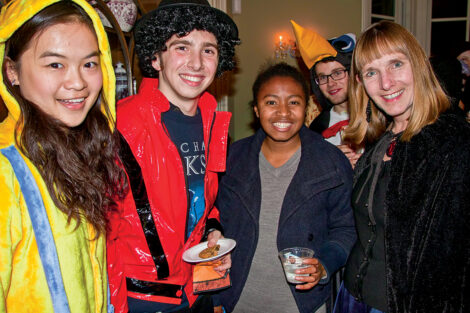

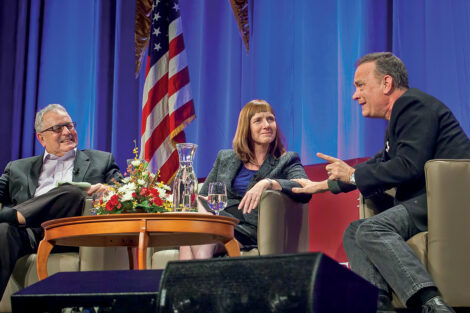
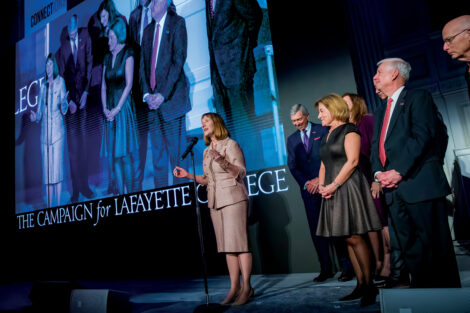

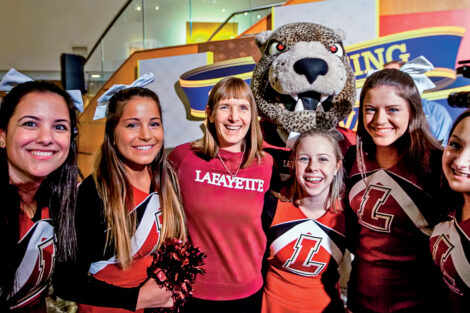
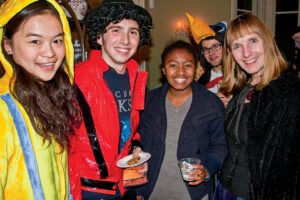

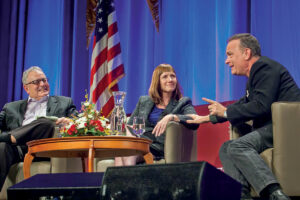
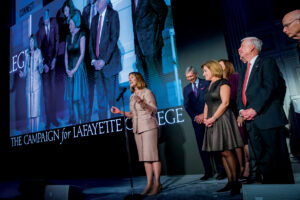

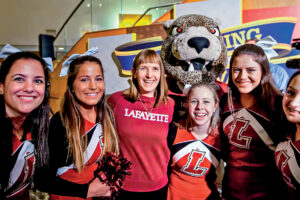
Byerly led the College through deliberations that addressed those best interests. An outline of smart, managed growth is what emerged. Abu Rizvi, an economics professor and provost for much of the Byerly presidency, says the strategic direction was driven by two “animating ideas”: a commitment to a liberal arts education (linked, in Lafayette’s case, to a long tradition in engineering); and a societal mission to make that education as broadly available to qualified students as possible. “Those are lofty thoughts,” Rizvi says. “The question was, how could we make that operational?”
Much of the answer had to do with resources: bolstering financial aid through the twin strategies of targeted fundraising and increasing the size of the student body. (More revenue from tuition-paying students, along with a set percentage of any tuition increase, would contribute to bolstering financial aid.) “One of the things that helped with buy-in for the plan is that it involved a number of constituencies in its design,” Rizvi says. “The idea that a Lafayette education should be more broadly accessible for students not able to afford it—that was met with a lot of agreement. So, too, was the idea that as you grew, you did not want to lose the quality of close faculty-student interaction. We wanted to make sure that through the process of growth—which is, after all, not enormous, about 15 percent over eight years—we would not change the character of the institution and the kind of education it offered.”
It may not change the character, but Byerly sees the new direction as furthering the mission. She compares the eventual impact to the shift, five decades ago, to coeducation. If their personal financial circumstances aren’t a factor, students of diverse backgrounds will be giving Lafayette a close look. Many will be drawn to a place with an enduring small-college feel and a breadth of curricular and extracurricular offerings. And when they get to campus, diverse backgrounds will bring different perspectives that mean a better educational experience for all.
The plan, pre-pandemic, was moving ahead of schedule: The applicant pool was growing in numbers, diversity, and academic credentials. Lafayette is not yet among the few thoroughly “need-blind” schools. Still, the financial aid budget had grown to the point that financial need was not weighing nearly as heavily as it once did in admissions decisions. While the pandemic has complicated the trajectory, Greg MacDonald, vice president for enrollment management, says, “We are positioned to come out of this moment quickly and with a strong enrollment.” Byerly “really understands the critical role that financial aid plays in meeting enrollment goals,” he adds. “And she helped educate the Lafayette community on that important point.”
Eventually the plan will mean 400 additional students (a number made possible by a new housing complex, opened this academic year, that borders the campus on McCartney Street), along with 40 additional faculty members. During her time as provost at Middlebury College, the position she held before the Lafayette presidency, Byerly had seen the dividends from a similar expansion; at Lafayette, “we’ve seen new energy, a refreshing of the intellectual community.”
That new energy is reflected in recent faculty hires. Many are in areas highlighted in an academic plan supporting the larger strategy: data science and digital scholarship; design, media, and the arts; environment and sustainability; global education; a new center focused on the humanities; and inclusive STEM education and studies. The plan has the College seeking out faculty of color across all disciplines, and also recruiting more women for faculty roles in the so-called STEM fields. And it stresses integrating and combining disciplinary work. As Byerly sees it, “Disciplinary boundaries are less definitional than they once were. Students are more attracted to areas of study that cut across disciplinary identities. Faculty feel the same way. Their closest colleagues are not necessarily in the same discipline, and the conversations they have around their intellectual work tend to be discipline-crossing.”
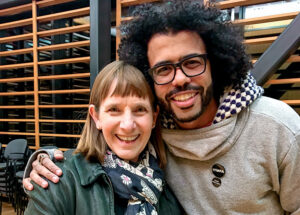
Award-winning actor/rapper Daveed Diggs earned notoriety portraying the Marquis de Lafayette in Broadway’s Hamilton. During a 2018 visit to campus, he praised Byerly’s lip-sync rendition of “Guns and Ships.”
Beyond her substantive contributions, Byerly carries symbolic importance as the College’s first female president. “In my early stages, I recognized that people naturally perceived me as different from all the Lafayette presidents who came before me,” she says. “It highlights what parts of the role are about you, and what parts are about the position. Even the tenor of presidential events is set by a particular style. Something as simple as whether the president is wearing a suit and tie and standing behind a podium, or whether the president is wearing a cocktail dress, can change the character of the event. Expectations on both sides had to be slightly recalibrated.”
Byerly acknowledges that a new president who had graduated from all-female Wellesley College, and one who had come to the position with no experience around Greek life or Division I athletics, might be greeted with anxiety by some. So she worked hard to get to know those areas in the Lafayette context. A relatively new colleague, Sherryta Freeman, became director of athletics about three years ago; she moved quickly to shape a strategic plan that covered the recruiting and retaining of coaches, ensuring a championship culture for student-athletes, enhancing the game experience for fans, finding new funding opportunities, and more. Byerly “wants athletics to be valued on this campus, and she recognizes that competition in sports adds to the core mission of the institution,” Freeman says. Freeman has tweeted out side-by-side cutouts of the president and the Marquis de Lafayette—cardboard stand-ins at home basketball games. Pre-pandemic, Byerly, wearing a familiar Lafayette sweatshirt, would be a very animated presence in the stands.
As for fraternities and sororities, long a source of debate and rethinking, the idea was to find ways to incorporate them more seamlessly into student life. “We wanted to think more intentionally about the residential experience, including how to present students with different options and to get them to see Greek organizations and other residential living groups as equivalent options,” Byerly says. “That meant, in part, embracing fraternities and sororities as part of the community. If they’re in good standing, they should be supported.” New standards for accreditation seek to increase accountability for Greek organizations, and the addition of the College’s first multicultural group this spring allows the Greek organizations to begin to reflect the diversity of the campus.
Byerly’s presidency coincided with commemorations of 50 years of coeducation. Mary Armstrong, who was on the search committee that brought Byerly to Lafayette, sees her as “both a symbol of what Lafayette has become and a symbol of its potential.” In her view, “Often an institution will be excited because there has been a first, like the first female president. But Alison represents the beginning of stronger diversity across our administration and the faculty. It’s not just about cracking the glass ceiling. It’s making sure people keep moving through it.”
She models a kind of excited intellectual interest, an ability to energetically engage across any number of topics and boundaries.
Armstrong, Charles A. Dana Professor of English and Women’s, Gender, and Sexuality Studies, agrees with Byerly that, in Lafayette circles, the woman-as-president reality came to feel less remarkable; it’s certainly unremarkable in academia generally. “After a while, when people thought of Alison, they thought of her simply as the president of Lafayette in terms of her excellence in leadership. But she has been a role model for students in particular. She models a kind of excited intellectual interest, an ability to energetically engage across any number of topics and boundaries. A woman who is so able, so capacious, so successful as president has had a positive effect across the whole institution.”
Both Byerly and Armstrong happen to be scholars of 19th-century British literature, and Byerly has taught in Armstrong’s classes several times. As Armstrong recalls: “It was somewhat jaw-dropping to have the president cross the Quad, come into class hauling stacks of first-edition books and manuscripts in canvas bags, and then talk with tremendous authority and knowledge about the publishing history of the Victorian novel. Students were so excited by a presidential visit. I remember one student telling me that right after class, he called his father and said, ‘This is the best college ever!’ For all the responsibilities of the president, Alison wasn’t distracted at all. She knocked it out of the park.”
During more normal semesters (three of them), Bilal Akbar ’18 served as Student Government president; he also had a summer stint working in Byerly’s office, and the two have stayed in touch after he graduated. “I think the overarching thread with all of our interactions was that I found her to be a good listener, empathetic, and willing to be bold,” he says. At biweekly meetings, they would catch up on her plans for the College, and she would offer feedback on the work of Student Government. “Over time, these sessions came to increasingly resemble counseling sessions,” Akbar says. “She always showed interest in how I was coping with personal challenges, which meant a lot.”
It also meant a lot, he adds, that Byerly strongly supported inclusivity and diversity. Her consistent stance “went a long way in making many students from marginalized backgrounds feel welcome on campus, including myself, an international student from a Muslim-majority country.” Following his graduation, Byerly wrote a letter of support as Akbar worked through a process to remain in the U.S. “Despite having the enormous task of president of the College, President Byerly always made herself available to students, and she would personally respond to emails students would send her way,” Akbar says. “Given the fact that she presided during a time of immense political and social turmoil in our country, she would always be willing to sit down with and listen to student activists and leaders. Many students who may not have been happy with the progress the school was making on important issues nonetheless appreciated the accessibility.”
The theme of Byerly as an accessible leader comes up again and again. “Alison likely has more personal connections to students, faculty, staff, parents, and alumni than anyone else on campus,” says MacDonald. “Yes, you could say that is the role of the president. But I would say few could do that so naturally and genuinely.”
Just as naturally and genuinely, Byerly has been a great confidence-booster around the ongoing project that is Lafayette. It’s the kind of confidence, she observes, that has allowed the College to commit to becoming bigger and more intellectually exciting, to support a level of financial aid that will help make diversity a real thing, to build a center that elevates the sciences and collaborative learning as well, to shape a curriculum that engages with the great challenges of our time. “I feel the College is well positioned,” she says. “The community feels good about where we are.”